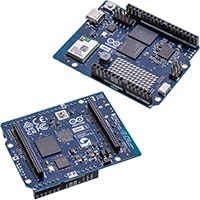
Scheme-it
Introduction



Projects
UNO Q Microcontroller Board
Arduino microcontroller boards provide advanced features and versatile applications for modern electronics
 The Arduino UNO Q is a high-performance, hybrid, single-board computer and microcontroller development board that redefines performance and versatility. Featuring cutting-edge USB Type-C® connectivity and built on the renowned UNO form factor, the UNO Q is designed to elevate projects. Equipped with a Linux Debian-capable MPU and a real-time microcontroller, this board is perfect for advanced applications in AI, computer vision, IoT, robotics, and industrial sectors.
The Arduino UNO Q is a high-performance, hybrid, single-board computer and microcontroller development board that redefines performance and versatility. Featuring cutting-edge USB Type-C® connectivity and built on the renowned UNO form factor, the UNO Q is designed to elevate projects. Equipped with a Linux Debian-capable MPU and a real-time microcontroller, this board is perfect for advanced applications in AI, computer vision, IoT, robotics, and industrial sectors.
The Arduino UNO Q seamlessly integrates with the Arduino App Lab development environment, empowering users to create groundbreaking applications across microcontrollers, embedded Linux, and edge AI. With its user-friendly examples and expandable capabilities through modular bricks, this powerful tool simplifies deployment with built-in orchestration. It helps users quickly and efficiently turn innovative ideas into reality.
- Hybrid intelligence: combines Linux and real-time MCU control on a single board for smart, responsive, edge-aware applications
- Simplified development experience: App Lab offers prebuilt examples, intuitive building blocks (bricks), and scalable deployment with transparent orchestration of software and containers
- Familiar form and unmatched power: maintains the iconic UNO footprint with integrated Wi-Fi®, Bluetooth®, Qwiic expansion, and an 8x13 LED matrix; fully compatible with existing shields and accessories while adding Linux processing, AI support, and high-speed I/O
- Streamlined App Lab platform: provides an intuitive environment to combine Arduino sketches, Python scripts, and containerized AI models into integrated applications
- Ready for AI and Vision at the edge: supports computer vision, sound recognition, and real-time automation for on-device intelligence.
- Two setups, one experience: can be used as a single-board computer with monitor, keyboard, and mouse, or connected to a host PC running App Lab for a familiar development workflow
- Expansion options: Qwiic connector, traditional UNO headers, and bottom-mounted high-speed connectors
- LED matrix: 8x13 blue LEDs
- User-controlled LEDs: four RGB LEDs
- Microprocessor:
- Qualcomm Dragonwing™ QRB2210
- Adreno GPU 3D graphics accelerator
- Two ISP (13 MP + 13 MP or 25 MP) at 30 fps
- Operating system: Debian Linux OS
- Digital I/O pins: 12 exposed on JMISC
- 16 GB eMMC
- 2 GB LPDDR4 RAM
- Operating voltage: 1.8 V
- Input voltage (VIN): 7 VDC to 24 VDC
- Wireless connectivity: Wi-Fi 5 and Bluetooth 5.1
- Microcontroller:
- Arm® Cortex®-M33 up to 160 MHz running Arduino Core on Zephyr OS
- 2 MB Flash memory
- 786 KB SRAM
- Floating point unit
- 2 MB Flash
- 786 KB SRAM
- 47 digital I/O pins (22 exposed on the JANALOG/JDIGITAL and 25 on JMISC)
- Six analog inputs on JANALOG
- Six PWM pins shared with GPIO
- Operating voltage: 3.3 V with 5 V tolerance
- Ideal for developing Internet of Things (IoT) applications, thanks to its enhanced connectivity and power management features. The UNO Q can be used to create smart devices that communicate with each other and the cloud, enabling automation and data collection in various environments
- Suitable for building and controlling robots with versatile I/O options and a high-performance microcontroller. The board can handle multiple sensors and actuators, making it perfect for complex robotic systems that require precise control and real-time processing
- Perfect for wearable technology projects due to its compact size and low power consumption. The UNO Q can be integrated into fitness trackers, smartwatches, and other wearable gadgets, providing reliable performance and long battery life
- Can be used to create smart home devices and systems, leveraging its robust connectivity and processing capabilities. The board can control lighting, heating, security systems, and other home appliances, making homes more efficient and convenient
- An excellent tool for learning and teaching electronics and programming, providing hands-on experience with a modern microcontroller board. The UNO Q is suitable for students and hobbyists who want to explore the world of embedded systems and develop their technical skills
- The UNO Q can be employed in industrial settings to automate processes, monitor equipment, and collect data. Its robust design and reliable performance make it suitable for harsh environments and critical applications
- The board can be used to build systems that monitor environmental conditions such as temperature, humidity, air quality, and more. These systems can be deployed in agriculture, weather stations, and other fields to collect and analyze data for better decision-making

The 9FGL0841 supports both Common Clock (CC) with or without spread spectrum and Separate Reference no-Spread (SRnS) PCIe clocking architectures. It can also be programmed with a user-defined power up default SMBus configuration. The outputs can optionally be supplied from any voltage between 1.05 and 3.3V; maximum power savings with ±100ppm frequency accuracy on all clocks.
The purpose of a clock generator is to produce a timing signal for synchronizing a circuit's operation. Its functions can be applied to most consumer electronic machines but it is commonly used on communication applications like routers, servers, and base stations.

Introduction



Help & Resources

Go to Calculators
Go to Calculators

Go to Reference Design Library
Go to Reference Design Library
Please type 'DELETE' (without quotes) to the below box to confirm the deletion:







